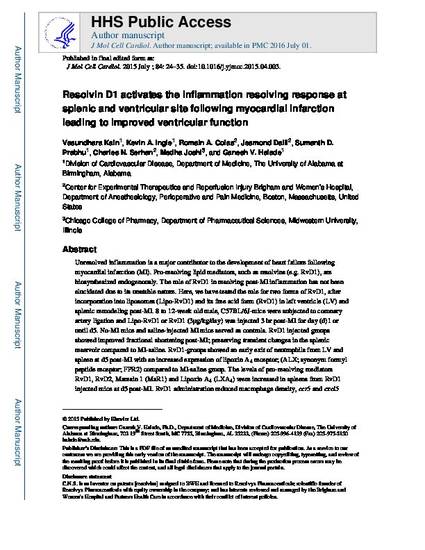
- Metabololipidomics,
- Myocardial infarction,
- Neutrophils,
- Resolution of inflammation,
- Resolvin D1,
- Splenic remodeling
Unresolved inflammation is a major contributor to the development of heart failure following myocardial infarction (MI). Pro-resolving lipid mediators, such as resolvins (e.g. RvD1), are biosynthesized endogenously. The role of RvD1 in resolving post-MI inflammation has not been elucidated due to its unstable nature. Here, we have tested the role for two forms of RvD1, after incorporation into liposomes (Lipo-RvD1) and its free acid form (RvD1) in the left ventricle (LV) and splenic remodeling post-MI. 8 to 12-week old male, C57BL/6J-mice were subjected to coronary artery ligation and Lipo-RvD1 or RvD1 (3μg/kg/day) was injected 3h post-MI for day (d)1 or until d5. No-MI mice and saline-injected MI mice served as controls. RvD1 injected groups showed improved fractional shortening post-MI; preserving transient changes in the splenic reservoir compared to MI-saline. RvD1-groups showed an early exit of neutrophils from LV and spleen at d5 post-MI with an increased expression of lipoxin A4 receptor (ALX; synonym formyl peptide receptor; FPR2) compared to the MI-saline group. The levels of pro-resolving mediators RvD1, RvD2, Maresin 1 (MaR1) and Lipoxin A4 (LXA4) were increased in spleens from RvD1 injected mice at d5 post-MI. RvD1 administration reduced macrophage density, ccr5 and cxcl5 levels at d5 post-MI compared to saline injected mice (both, p < 0.05). Increased transcripts of mrc-1, arg-1 and Ym-1 (all, p < 0.05) suggest macrophage-mediated clearance of necrotic cells in RvD1-groups. RvD1 reduced the pro-fibrotic genes (colla1, coll2a1 and tnc (all; p < 0.05)) and decreased collagen deposition, thereby reducing post-MI fibrosis and thus stabilizing the extracellular matrix. In summary, RvD1 and Lipo-RvD1 promote the resolution of acute inflammation initiated by MI, thereby delaying the onset of heart failure.
Journal of Molecular and Cellular Cardiology, v. 84, p. 24-35
This article is the post-print author version. Final version available at: https://doi.org/10.1016/j.yjmcc.2015.04.003
Available at: http://works.bepress.com/ganesh-halade/66/